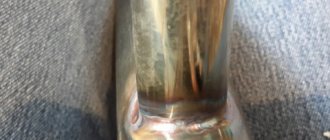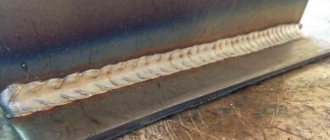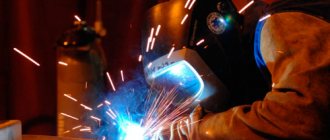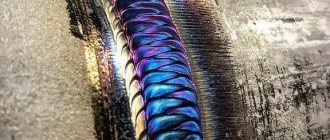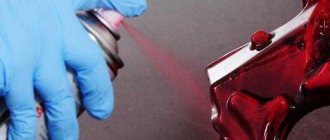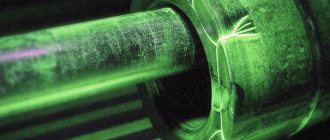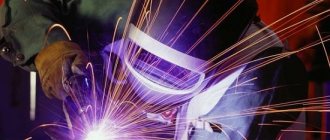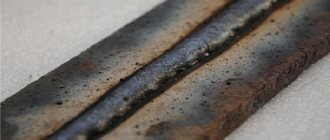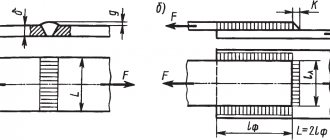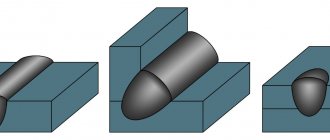Corrosion poses a great danger to metal. This process leads to its gradual destruction and failure of large metal structures. The situation poses a danger to people and equipment.
But metal corrosion is often associated only with its surface. This is not true.
Rust can also develop in welds. Even if the sheet or steel part is well protected from corrosion, the danger to the joint remains high.
To prevent the development of the process, it will be necessary to protect the welds from corrosion. Let's look at how to ensure safety and what you should pay attention to first.
Types of weld corrosion
After welding, the corrosion process can be external, internal or combined, which in its own way affects the appearance of the joint and deteriorates its characteristics. According to the type of corrosion there are:
- Solid
. It is divided into uniform (penetrates to the same depth throughout the entire upper layer) and uneven. Occurs in unalloyed metals and carbon steels. Rust covers the entire surface of the seam, so the connection deteriorates faster if nothing is done to protect it. - Local
. It appears in the form of spots, dots, ulcers in certain areas of the seam. Observed in Kh12MF steels and welding joints depleted of chromium. - Knife
. Has a thin line at the boundary between the weld and the base metal. It flows along the edge of the metal grains throughout the entire thickness, and not just from above, so this is a dangerous type of corrosion. Found on alloyed, austenitic steels and high-carbon alloys.
Tinning of welds
When using this method, another material is fused onto the weld seam, which acts as protection. For these purposes, tin or its alloys are usually used.
Afterwards, the seam is processed mechanically until the required shape and thickness are obtained. Next, the weld is heated using a gas torch. The other hand applies solder. As it melts, the tin slowly spreads. After the solder cools, a protective film appears.
This method is suitable for domestic use. All you need is a torch and tin. All this will take a little time.
It is worth understanding that for each method it is necessary to create appropriate conditions.
Corrosion Prevention Methods
Protection of the weld seam from corrosion is carried out using chemical, thermal and mechanical processes. Having considered the technology and the necessary tools for each method, you will be able to choose the one suitable for your working conditions.
Annealing
To remove temperature stresses in the structure after welding, the product is annealed. This occurs by heating the part to 800 degrees. It is then placed in an aqueous solution of sodium chromium (3%) containing corrosion inhibitors. Thanks to this treatment, stresses are smoothed out and the seam “absorbs” chromium molecules. This extends the life of the weld joint and protects against rust.
But this method requires equipment and conditions to heat the product up to 800 degrees. This can be done using a gas burner or in a large oven. Then a large container is required into which the part with welding seams is dipped. Consequently, large structures are difficult to process at home. The annealing process (heating and subsequent cooling) takes time, which affects productivity with a large batch of identical products.
Anodizing
An electrochemical process in which protection of welds from corrosion is achieved by creating a particularly strong film on the surface. The process occurs in the following sequence:
- The seams are pre-etched by treating with nitric acid. The rest of the surface is simply degreased with solvents (white spirit, acetone, gasoline).
- Lead sheets are placed at the bottom of the bath. Voltage contacts are connected to them so that the conductor becomes the cathode.
- The container is filled with sulfuric or chromic acid. A sulfur medium is used more often because the process requires less electricity. Chromic anhydride is more expensive.
- A second pole is connected to the product so that it plays the role of an anode.
- The part is immersed in the bath and voltage is applied. Anodizing occurs, creating a stable, especially durable top layer.
- The product is removed and washed with hot water to remove acid. Hot water helps to reduce pores in the metal and compact the protective film.
- The part is then dried.
Anodizing requires electricity, chemical solutions and a container that can accommodate the structure with welding seams. Therefore, it is possible to create conditions for such a method of protection only in production. In everyday life, it will be possible to organize anodizing only for small products.
Tinning
Tinning a weld seam is the fusing of another material onto its surface that serves as protection. Tin or its alloys are most often used because they have a relatively low melting point. The welding seam is processed mechanically to the desired type, thickness, and shape. Then the joint surface is heated with a gas torch or blowtorch. With the second hand, solder - a tin rod - is fed into the heated zone. It gradually melts and the tin spreads over the surface of the base metal. When the solder cools, a strong protective film is formed that is resistant not only to corrosion, but also to mechanical stress.
The method can be implemented at home, in a garage or workshop. You will need tin and a blowtorch. But the tinning process itself is time-consuming and requires accuracy and patience. Working on vertical surfaces is complicated by the laws of gravity - molten tin drips down. Therefore, the method of protecting the weld seam is suitable only as a one-time use, and for serial use you need to look for another method.
Puttying, priming
The protection technique is often used in auto repair shops to protect seams when replacing arches, sills, and other parts of the car body. After welding, the seams are cleaned and puttied to create a smooth surface and hide traces of welding work. Then the surface is primed, painted and varnished. The process is very painstaking and requires a lot of experience and skill, otherwise the welding seam will be visible. If the rust in the heat-affected zone is not properly removed, corrosion will continue under the paintwork and soon the paint will swell and everything will need to be redone.
Selection of additive and wire
When welding stainless steel, some of the alloying elements burn out under the influence of high temperatures. To compensate for losses, choose wire with an increased chromium content, so that the weld remains as close in composition to the base metal as possible. But this technology for protecting the seam from corrosion is applicable only with alloyed metals. There are no analogues for low-carbon and carbon structural steel.
Causes of corrosion during welding
The appearance of corrosion primarily at welded joints is due to two reasons:
- the breaking of primary intercrystalline bonds and the formation of new ones, different in their mechanical properties from the previous ones, as well as the appearance of stresses in the metal structure.
- changes in the chemical composition, the appearance of oxides (endogenous non-metallic inclusions), which are stress concentrators in the structure;
- the formation of a galvanic couple due to changes in chemistry. composition of the weld.
The influence of the above changes increases in proportion to the degree and intensity, number and size. The rate of the oxidation reaction is additionally determined by operating conditions: climatic component, physicochemical influence (working environment).
What do we offer
The AKRUS® trademark develops and selects protective compounds for individual orders with the required properties. We also have ready-made formulations suitable for even the most extreme operating conditions. We offer professional application of anti-corrosion coatings using specialized equipment, in full compliance with GOST paint and varnish standards and customer wishes.
Our specialists accompany all the necessary stages of work - from inspecting the objects being processed and their preparation to applying primers, finishing coatings and quality control of work.
Criteria for choosing joint sealant
Various types of sealants are created for cars: for the body, pipe joints, hatches. The differences between the compositions lie in the degree of heat-resistant, elastic properties, and durability of the processing result. The most effective are considered to be professional types, which are sold in large volumes, and it is advisable to take them for auto repair shops when a lot of similar work is carried out.
For independent one-time processing of welding seams, it is advisable to purchase small tubes of 40-200 grams. If you take a similar type, then it is advisable to leave the choice on an aluminum tube; the container allows you to maintain the technical characteristics without changing the entire shelf life.
The plastic option is cheaper, then you should use a sealant if its shelf life lasts at least six months.
There are options for sealants on sale, with a provided tip, which can be used to fill welding seams and corners conveniently. Body sealant in cartridges can only be applied using a special gun.
The differences between the compositions lie in the degree of heat-resistant, elastic properties, and durability of the processing result.
Mechanical methods and heat treatment after welding
Minimal processing is the removal of slag and scale by grinding the seam with a stainless steel brush. In some cases this is not enough and additional chemical treatment is necessary. Sanding with fine-grit sandpaper is very common.
Etching a stainless steel product using acid.
Mechanical methods include sand blasting, liquid abrasive and hydro-sandblasting. A prerequisite is a minimum iron content in the sand. After such cleaning, the surface is passivated.
Heat treatment of stainless steel is divided into several types: hardening (maximum temperature and rapid cooling), annealing (heating the metal and slow cooling), normalization (similar to annealing, the difference is that cooling occurs in fresh air and not in a furnace), tempering ( carried out after hardening).
The final result and quality of the product depend on proper heating of the workpiece. When exposed to heat, metal changes its structure and properties. When overheated, it acquires an undesirable coarse-grained structure. It is necessary to monitor the heating temperature very carefully. For example, a burnout is a defect that can no longer be corrected.
Chemical-thermal treatment of stainless steel - heat treatment with the application of various elements to the surface (chrome, aluminum, nitrogen, etc.)
Read also: Types of metal welding
Safety precautions
Cleaning of welded seams can only be done in a special form, in compliance with all safety regulations. So, when working with chemicals, protect your hands, respiratory organs, and eyes.
Note!
Such work is carried out by a specialist with education and skills, over 18 years of age.
Welded areas are protected, as these are one of the most fragile areas of any metal structure. And if they can be strengthened, it is worth making every effort to ensure that the welded structure lasts as long as possible. For this purpose, there are methods for cleaning welds described in this material.
Purpose of seam sealants
Welded seams require additional protection so that the metal structure lasts longer and negative processes do not occur on the material, for example, corrosion does not appear. The purposes of sealants are as follows:
- Waterproofing layer for seams or base;
- Closing cracks and gaps;
- Repair work on planes with flaws and cracks.
The products differ in the level of shrinkage following curing. Having treated the metal with the composition, there is no need to be afraid that vibration effects will affect the integrity of the seam; the layer can stretch and bend. The product is used for pipelines, heating systems, in parts of various devices and for other items, depending on the chosen type.
When welding channels, high-quality electrodes are used. In this case, the drawings should be carried out in accordance with the ESKD, after which additional processing of the seams is also sometimes used.
Welds require additional protection to ensure that the metal structure lasts longer.
Sealant application technology
The use of sealant for a car has certain requirements. You need to know the operating rules described below:
- First, the base must be cleaned of all types of contaminants, including removing rust and degreasing the base;
- To increase the degree of adhesion, stripping is carried out with red Scotch Brite;
- A primer solution for metal surfaces is applied when such a step is indicated in the instructions for the sealant;
- Prepare the composition, place the tube in the gun, open the tape, or prepare a brush or spatula for applying the product;
- The product is distributed at the same speed and preferably in one go, so that the seam comes out optimally even.
The excess part of the layer is removed immediately with a spatula or simply with a gloved finger. If the layer is excessively sticky, sprinkling with water will reduce the problem. The layer can be painted after the time indicated on the packaging.
The product is distributed at the same speed and preferably in one go, so that the seam comes out optimally even.
What does the magazine consist of?
The document is drawn up in the form of a cover with a title and back side, as well as an internal part. On the last page there are signatures of the persons running the journal and managers, and stamps are affixed. Each page, except the title page, is numbered. The document is stitched for convenience. The cover can be made of thicker paper.
At the very beginning, the start date of logging and the end date of its logging should be indicated. If the second date is usually entered upon completion of the journal, then until that moment it is considered to be indefinite.
On the second side of the title page the following information is filled in:
- The name of the company that performs the work.
- The name of a specific construction project.
- Position, full name and signature of the financially responsible employee who keeps the log and is responsible for the reliability of the anti-corrosion protection of the welded joints made.
- Who developed the design documentation and drawings (name of the organization and its address).
- Project code.
- If available, the name of the institution that was involved in the development of the project, design activities for this organization as a whole (information not required to be filled out).
- The company that manufactured the structures mentioned in the magazine (with address data).
- Work project code.
- Name and signature of the representative (or head) of the customer organization (if any).
- Start and end dates.
In addition to the title page, the document contains a voluminous tabular section.
It is located on each subsequent page and is filled out by two employees. One of them is the performer of the work, the second is his immediate supervisor. Attention! The table should be filled in as work progresses. Each column corresponds to one stripped and strengthened connection. If anti-corrosion protection of several connections was carried out in one work shift, then information about each is placed in a separate line.
Timely and reliable journal keeping will help the accountant with payroll, satisfy the curiosity of inspection organizations and make the execution of work a more orderly process subject to accounting.
Heat treatment
Thermal stripping is most often suitable for structures with thin walls, such as pipelines, reactor vessels, pressure vessels, etc.
The procedure will restore the strength of the material, reduce the effect of internal metal stress on the seams, and also ensure durability of the joints. And because of this, the entire structure will become more reliable. But all these benefits can be obtained if the work is performed by a specialist. After all, the slightest mistake will lead to defects that cannot be corrected. It is also important that high-quality tools are used during thermal stripping, however, they will be very demanding on energy, this will also need to be taken into account.
The technology itself for thermal stripping of seams assumes that the part will first be heated and then cooled in compliance with the correct temperature regime.
Heat treatment restores metal strength and improves joint properties
The heat treatment process involves first heating the area around the seam and the seam itself. The part remains in this state for a period of time (depending on the processing method), and then cools.
